To celebrate the 106th anniversary of Bolling Hall as a museum on the 22nd September 2021, and inspired by the TV programme ‘A House Through Time’, one of our Assistant Curators, Dr Lauren Padgett, has researched how Bolling Hall was ‘home sweet home’ to different Bradfordians in the late 19th and early 20th century.
Bolling Hall was lived in by wealthy owners for centuries. Things then changed in 1816 when owner Sir Francis Wood sold Bolling Hall to the Bowling Iron Company. When Mr Paley, one of the company partners, took ownership of it in 1821, he began to rent it out to other families. Building on previous research by past curators, I set out to discover more about these tenant families.
I began with the knowledge that Rev. N. T. Heineken was one of the first in a long line of these tenants; it is believed he lived there from 1822 to 1827. This is supported by an entry in the published journal of Dr John Simpson who on the 2nd February 1825 “called to see. . . Miss Heineken who lives at Bolling Hall”.
To learn more, I first looked at the census records. The census record for 1841 shows two households living at Bolling Hall. Jane Clough, head of one family and a ‘sempstress’ (seamstress), is living there with another woman called Mary Beck and two small children. Miles Illingworth, head of the other household, is living with Elizabeth Illingworth, and two servants. There are further servants living at ‘Bolling Hall Gates’, which could possibly be referring to gatehouse connected to the Hall which appears in later census records. By 1851, the families living in Bolling Hall have changed and this census documents the Walker family now living there, headed by William, a magistrate, with his widowed mother, his wife Kezia and seven children. They had a governor, a cook housekeeper, six maids, a nurse, a coachman, footman, gardener and laundress. Although listed as living at Bolling Hall, I suspect some of the servants lived in the Hall’s outbuildings and connected properties, such as the gatehouse, coachman’s house and the lodge which are listed separately to the Hall in other years.
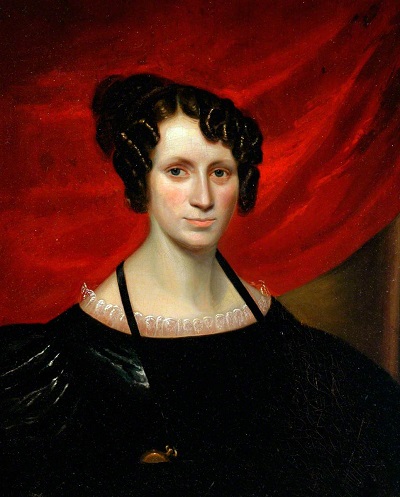
Caption: Oil painting of Mrs Kezia Walker who lived at Bolling Hall. In Bradford Museums’ collection.
The 1871 census lists the Tankards as the Hall’s tenants. James, head of the Tankard family, was a wealthy worsted spinning mill owner. They had a governess, a housekeeper and four maids with a coachman living in the coachman’s house with his family. In 1881, the Tankards had a cook, three maids, and a nurse. The 1891 census shows that the family living in the Hall has changed again with Arthur Ellis, a mechanical engineer, living there with his wife Amy, four young sons and a nephew, as well as a nurse, cook and three maids. It also shows a John Freeman, a gardener, with his wife Jane and grandson living at the ‘Tower Bolling Hall’. Could John had been the gardener for the Ellis family living in Bolling Hall’s pele tower?
It seems that after this period, Bolling Hall was split into separate dwellings and several families lived here at the same time. These were not rich families compared to the magistrate William Walker and mill-owner James Tankard; instead these new residents had humble occupations. The 1901 census shows there are now several families living at the Hall. There is Thomas Lister, a wool and noil dealer, living in the Hall with his wife Elizabeth, and two adult sons Thomas (Junior) and James, and daughter Clara. Another Lister household is living here too; this one headed by Fred Lister, a wool sorter, with his wife Amy. Fred could possibly be the married son of Thomas and Elizabeth. Another family are the Woods; Thomas, a stuff warehouseman, with his wife Annie, two young sons and daughter. Then there’s the Sutton family, with William, a coal merchant and carting agent (listed as an employer, rather than a worker), with his wife Elizabeth and adult son Percival. It is believed that the Suttons lived in the older wing and kept the Housebody/Great Hall as a parlour, and used the Blue Bedroom as a master bedroom. The other family is headed by Mary Johnson, a widowed tailoress, living with her adult son Ernest who works in a woollen warehouse.
The 1911 census record indicates that the occupiers of Bolling Hall were two Watts households, the Warburton family and the Parrington family. Of the two Watts households there was one headed by John James Watts, a letterpress machine man, who lived in three rooms with his wife Gertrude and a lodger called Charles Hartley, a general labourer. The other was headed by James Watts, a tailor, who lived in four rooms with his wife Diane, and three adult children: Isaac, a commercial clerk; Mary, a stamper in the print industry; and Charles, a messenger. It is probable that John was the married son of James and Diane, living separately in his own rooms with his wife. Tetley Parrington, a stuff warehouseman, lived there in three rooms with his wife Elizabeth. Then there was James and Margaret Warburton living there in three rooms with their son James, a stuff and woollen warehouseman.
As census records just give us a snapshot at ten-year intervals, I turned to other sources, such as electoral registers and newspapers, to see if these can give an insight into other tenants of Bolling Hall. I found John Aked listed in an electoral register as living at Bolling Hall in 1832 and 1835. There is also Michael and Thomas Horsfall registered as living at Bolling Hall in 1832. William Walker appears in the electoral registers as living there from 1847 for years with his son Charles Walker being registered as living there in 1870, suggesting that the Tankards must have moved in afterwards in time for the 1871 census. Newspaper articles also confirmed the Walker’s living at Bolling Hall in the 1860s. One article in 1861 announced the birth of a daughter by “the wife of Captain Walker” “at Bolling Hall”. Another article in May 1863 about a payment dispute places the Walker family there too. A newspaper article from January 1884 states that “Mr James and Mrs Tankard, of Bolling Hall” celebrated their silver wedding anniversary indicating they were still living there in 1884 at least, but previous research suggests they may have lived there until 1887. The electoral register for 1903 lists one of the previously mentioned Thomas Listers, while the 1904 register indicates that Thomas Lister Junior is registered as living there and then both Thomas Senior and Junior in 1905. The previously mentioned Sutton family appear to have lived at Bolling Hall in the years from 1906 to 1910, as a Frank Albert Sutton is registered as living there for those years.
In our collection, we have some glass lantern slides which show us what some of Bolling Hall’s rooms looked like during this period. Earlier this year, these were printed and put in the corresponding rooms for an exhibition called ‘Home Sweet Home: Old Photographs of Bolling Hall’. They are fascinating to see. In the slide of the Ghost Room, a Victorian cast iron bedframe (just off to one side), an Art Nouveau dresser at the back and an awkwardly hung painting look out of place in the Jacobean room. A slide of the Housebody or Great Hall shows it highly decorated with heavy antique furniture, multiple portraits hung on patterned wallpapered walls and Victorian bric-a-brac. If you look closely, I’m convinced the fire grate in the fireplace in the photograph is the same one we still have there today. We don’t have a date for this photograph but due to the room’s lavish nature, we previously thought it might be when the Tankards lived there, but given that it’s believed that the Suttons had the Housebody as a parlour and William Sutton’s status as an employer (rather than worker), it could be showing their parlour.
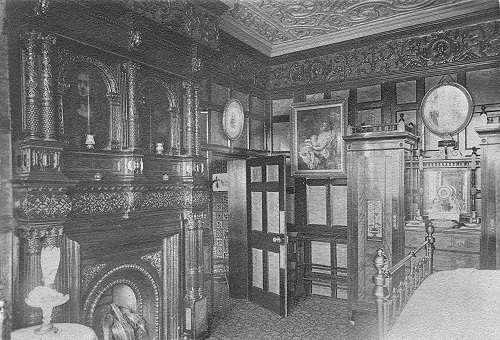
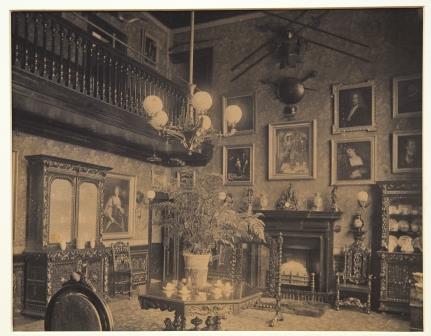
Two other slides show opposite ends of the Georgian Drawing Room, one towards the windows and one towards the interior doorways. Together they show multiple table-tops and the fireplace mantle cluttered with ornaments, walls hung with paintings and pictures, heavy covers over tables, sofas and a piano, along with an excessive amount of seating options and cushions scattered on the floor.
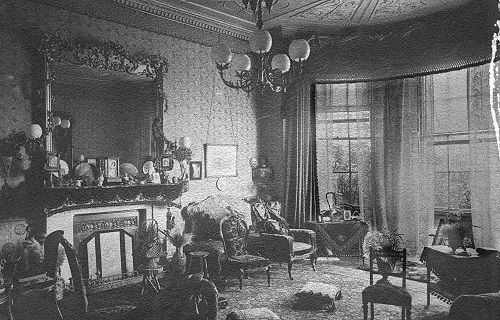
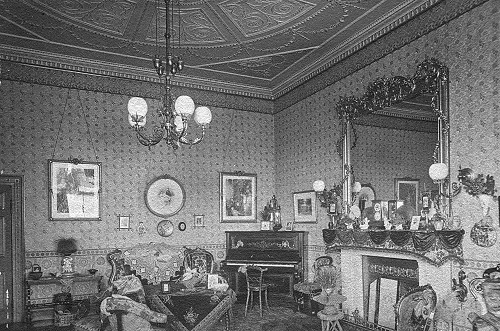
Another slide shows the Drawing Room taken at a different time to the others. This one actually shows the tenants – there is a woman sat at the table in the foreground with a man sat in a chair in the background. But who are they? Again, we have no date for this. Past curators associated this photograph with the Oddy’s who were believed to be tenants at Bolling Hall, occupying the downstairs rooms in the Georgian wing. But the Oddy’s didn’t appear in any of primary sources I looked at and given the number of families discovered to be tenants at Bolling Hall, several fit the bill. They look to be a bit more modest, with humble decorations and furniture, than the other tenants. There appears to be a rag-rug on the floor in front of the fireplace, contrasting the large patterned woven carpet rugs in the other two slides. The man is sitting in a plain wooden chair, not an upholstered armchair like those in the other slides.
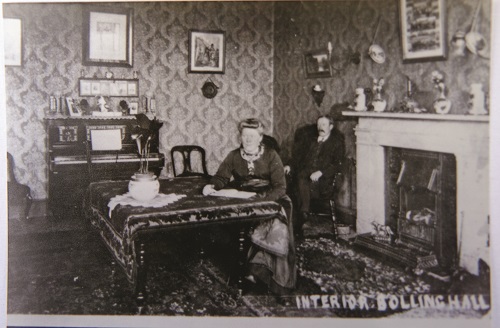
The other month, I was going through an old filing cabinet of paperwork (pages of research notes and correspondence etc.) collated by past curators. I found a folder of original and photocopied photographs of Bolling Hall over the decades. Flicking through them, I paused on two that didn’t look like Bolling Hall at first glance and pulled them out for further inspection. One shows a tree-lined path leading to an ivy-covered hall. If you look closely, there is a woman holding a baby or small child in the open doorway. I counted the vaguely familiar windows and noted the size, shape and positioning of them. Yes, it is Bolling, showing the back entrance at the car park side of the Hall, but not as I have ever seen it before. That tree-lined path in the photograph that would have run from Brompton Ave to the doorway is faintly visible under today’s grassed area. Bolling Hall looks quaint, like a chocolate-box cottage, in the photograph – the sharp architectural features of the Hall softened by ivy. On the back someone had written “William St. George Walker in his nurse’s arms at Bolling Hall. His date of birth: July 10, 1859”. It’s showing a recent addition to the Walker family. Studying the photograph further, I could make out the outline of a cross on the door next to the maid. It rang a bell. I went back through our digitised glass lantern slides and there it was – one showed a close up of the very same cross-shaped door knocker. Another photograph is taken from the same perspective with ivy-covered Bolling Hall, but this one has a young boy stood on the path. On the back it says “Bolling Hall, North Front, about 1880”. During this time the Tankards would have been residing at the Hall. Referring back to the census record for the year after, 1881, the Tankards had two sons, one identified only by the initials C. M., aged 14, and another called Herbert, aged 10. Given the boy’s height, this could be Herbert Tankard.
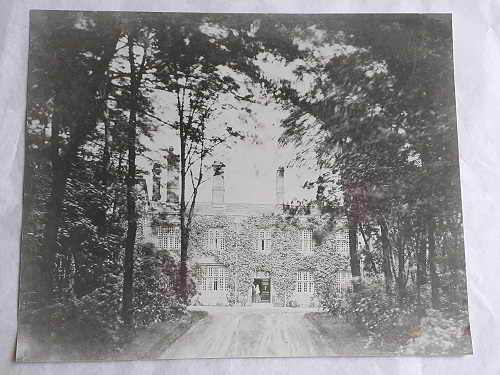
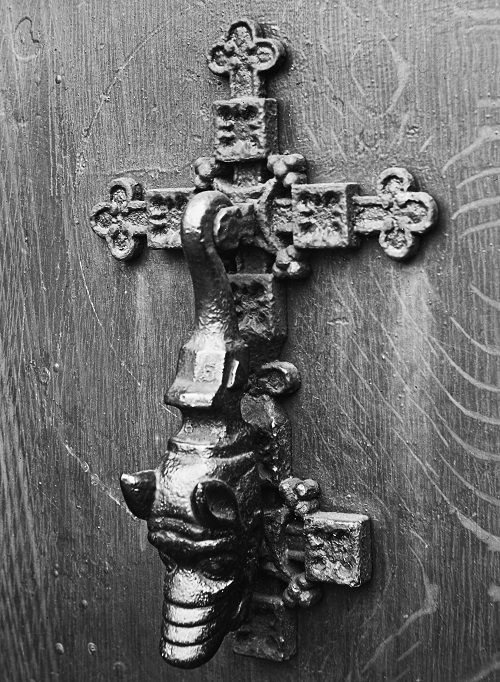

It has been fascinating to research this chapter of Bolling Hall’s life; it has revealed several tenant families that were previously unknown to us. For me, the juxtaposition is remarkable – the working class tailoress, letterpress printer or wool sorter working long hours for little pay in not the best conditions returning home to Bolling Hall, one of the grandest and most historical buildings in Bradford. Did John Freeman, gardener for the Ellis family, know that his family was living in the most southerly Medieval pele towers in the country? Did the couple sat posed for the photograph know that their parlour had been designed by the prolific John Carr, architect to the country’s crème de la crème, in the 18th century? Did the person who laid asleep in the cast iron bed in the Ghost Room dream about the ‘woman in white’ who supposedly appeared in that very room? Did they know that the ceiling they stared at when they couldn’t sleep at night was a rare 17th century plaster ceiling? We may never know what the tenants thought of their ‘home sweet home’ but we are keen to collect objects original to Bolling Hall during this period as well as stories and information about the families connected to it so please contact the Collections Team if your ancestor lived there (Email: collections@bradford.gov.uk).
The exhibition ‘Home Sweet Home: Old Photographs of Bolling Hall’ runs until March 2022. Details can be found here: https://www.bradfordmusgal.local/whats-on/home-sweet-home-old-photographs-of-bolling-hall
4 Responses
Hi, my grandfather was Herbert (Bertie) Edward Tankard pictured as a 10 yr old standing in front of Bolling Hall. He was a wool buyer in Australia for his father James Marsland Tankard. Interestingly my sister visited Bolling Hall some years ago and when she tried to enter the ghost room was hit with a shock of energy similar to hitting an electric fence (she couldn’t enter the room). I loved reading your article, thank you. I have lived in Australia all my life but will try and visit soon.
Thank you so much for sharing that information with us.
I seems to befit Bradford well. The gentry ‘class’ and the working ‘class’ all living in the same house and having the same home.
My family tree in archives had greenhough in family tree in Bradford and goes all the way down to John greenhough 1590 and cuts off however I have found a Elizabeth Illingworth as a children I will look into it more obviously now we had Joyce from Ireland and they married into greenhough family it’s interesting